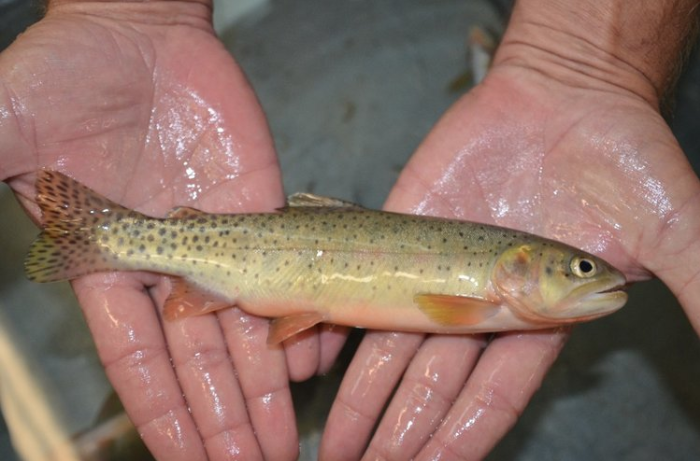Photo courtesy Colorado Parks and Wildlife.
By Garrett Hanks
Extinction, as the saying goes, is forever. Reincarnation? Let’s just say the jury is still out.
But the case for rebirth grew significantly stronger over the summer when Colorado Parks and Wildlife confirmed the rediscovery of a native trout species long considered extinct. Thanks to a pair of DNA samples housed in the Smithsonian National Museum of Natural History, we now know that the genetically distinct San Juan cutthroat trout continues to endure in its native habitat, transcending all the odds.
In the lexicon of biological jargon, there are “splitters” and there are “lumpers,” terms first credited to Charles Darwin as they pertain to differentiating species. Where the lumpers take a broad gestalt view of taxonomy focused on signature similarities, splitters focus on precise definitions and classify things (fish, in this case) based on the traits that set them apart.
Chalk one up for the splitters here.
Historically, every major river basin flowing from Colorado’s interior once held its own sub-species of native cutthroat trout, with distinctive genetic markers for trout from each area. The Colorado River cutthroat, Rio Grande cutthroat and the South Platte’s Greenbacks have all been identified as alive and, for the most part, well. The Arkansas and San Juan basins were credited with unique lineages of their own — the yellowfin cutthroat that disappeared from the Arkansas headwaters in the early 1900s, and the San Juan cutthroat presumed to have suffered a similar fate.
But that grave assumption was laid to rest this year when biologists managed first to find and then unscramble the genetics of these sequestered fish by verifying their DNA against 144-year-old samples at the Smithsonian. The (re)discovery revealed a trout that’s closely related to the Colorado River cutthroat yet endemic to the San Juan basin.
In addition to their genetics, it’s the story of these resilient fish that makes them so distinct. Through the glacial carving of the San Juan Range, the geological epochs that formed our rivers and shaped our landscape, this fish evolved to match the landform. And it can be found nowhere else on earth.
At one point in time, the San Juan River had sufficiently cold water to harbor trout over the 380 miles to its confluence with the Colorado River, and San Juan cutthroat may once have occupied the entirety of the cold waterways in the San Juan basin — from the creeks above Silverton to the stretch known as the “quality water” in New Mexico and beyond. These days, the San Juan River’s coldwater habitat extends only a few miles below Navajo Reservoir.
Over the course of history, the fish migrated upstream from the Colorado River to the remote headwaters of the San Juan Mountains, persisting in isolated populations for centuries despite the threats of a warming climate, wildfires, development and the stocking of non-native trout.
Even there, populations faced extinction as recently as this summer, when the raging 416 Fire ravaged the landscape surrounding their Hermosa Creek bastion and sent a CPW crew racing up the hillside to rescue some 58 San Juan cutthroats from fire and ash. State biologists are now holding them in hatchery quarantine tanks for breeding and eventual reintroduction to their native range.
While we will never know the full extent of the fish’s mysterious past, we are now responsible for its future.
As news spreads and plans are laid, Trout Unlimited stands to play a pivotal role in the story of these fish. We are excited for the chance to participate in the management of the species and the habitats in which they reside. Native trout are why we fight for protections like the Hermosa Wilderness, why we dedicate years to restoration projects, and why we strive to be leaders in public land management. This discovery is where Trout Unlimited’s mantra of “Protect, Reconnect, Restore and Sustain” happens on the ground.
We look forward to working with all partners – state and federal game and fish agencies, land managers, local tribes, municipalities, and other stakeholders — to realize a robust population of San Juan cutthroat trout across their native range.
This fish represents the landscape in which it was born. The rugged peaks and hidden folds of its remaining strongholds provided the protection to hold on against all odds. We celebrate the San Juan Mountains for their ruggedness and their propensity to preserve the treasures of the natural world. Where the last grizzly bear population in Colorado came to an end, we have an opportunity to preserve the legacy trout of the same landscape. Through collaboration, land management, and an engaged public, we can one day soon experience the magic of a native trout swimming the waters of its native range.
The San Juan cutthroat trout, the same fish seen by the Ute people who first called the region home, are now our fish too. A local treasure, they offer our fish-friendly community a renewed sense of pride. And they will need all of our help.
Garrett Hanks is the Southwest Public Lands Coordinator for Trout Unlimited. He lives in Durango.



